Abstract
OBJECTIVES:
Transcranial magnetic stimulation (TMS) has been used to measure cortical excitability as a functional measurement of corticomotor pathways. Given its potential application as an assessment tool in stroke, we aimed to analyze the correlation of TMS parameters with clinical features in stroke using data from 10 different centers.
METHODS:
Data of 341 patients with a clinical diagnosis of stroke were collected from studies assessing cortical excitability using TMS. We used a multivariate regression model in which the baseline cortical excitability parameter "resting Motor Threshold (rMT)" was the main outcome and the demographic, anatomic and clinical characteristics were included as independent variables.
RESULTS:
The variable "severity of motor deficit" consistently remained significant in predicting rMT in the affected hemisphere, with a positive β coefficient, in the multivariate models after sensitive analyses and adjusting for important confounders such as site center. Additionally, we found that the correlations between "age" or "time since stroke" and the rMT in the affected hemisphere were significant, as well as the interaction between "time since stroke" and "severity of motor deficit".
CONCLUSIONS:
We have shown that severity of motor deficit is an important predictor for rMT in the affected hemisphere. Additionally, time since stroke seems to be an effect modifier for the correlation between motor deficit and rMT. In the unaffected motor cortex, these correlations were not significant. We discuss these findings in the context of stroke rehabilitation.
Research Department
Research Journal
Neurophysiol Clin. 2016 Feb;46(1):53-61
Research Member
Research Publisher
Published by Elsevier SAS
Research Rank
1
Research Vol
46(1)
Research Website
pubmed
Research Year
2016
Research_Pages
53-61
Research Abstract
 Do you have any questions?
Do you have any questions? 

